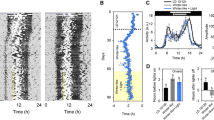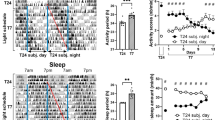Abstract
The lack of appropriate animal models for affective disorders is a major factor hindering better understanding of the underlying pathologies and the development of more efficacious treatments. Because circadian rhythms play an important role in affective disorders, we recently suggested that diurnal rodents can be advantageous as model animals. We found that in diurnal rodents, short photoperiod induces depression- and anxiety-like behaviors, with similarities to human seasonal affective disorder. In a pilot study we also found that these behaviors are ameliorated by morning bright light administration. In the present study we further evaluated the effects of morning and evening bright light administration on short photoperiod-induced depression- and anxiety-like behaviors in diurnal fat sand rats. Animals were maintained under short (5L:19D) or neutral (12L:12D) photoperiod and treated with morning or evening bright light or red dim light as control. Morning bright light ameliorated the behavioral deficits in the elevated plus maze and social interaction tests whereas evening bright light was effective only in the social interaction test. This is the first detailed presentation of the effects of bright light treatment in an animal model and a clear demonstration to the advantages of utilizing diurnal rodents to study interactions between circadian rhythms and affect.



Similar content being viewed by others
References
Ashkenazy T, Einat H, Kronfeld-Schor N (2009a) Effects of bright light treatment on depression- and anxiety-like behaviors of diurnal rodents maintained on a short daylight schedule. Behav Brain Res 201(2):343–346
Ashkenazy T, Einat H, Kronfeld-Schor N (2009b) We are in the dark here: Induction of depression- and anxiety-like behaviours in the diurnal fat sand rat, by short daylight or melatonin injections. Int J Neuropsychopharmacol 12(1):83–93
Ashkenazy-Frolinger T, Kronfeld-Schor N, Juetten J, Einat H (2009) It is darkness and not light: depression-like behaviors of diurnal unstriped nile grass rats maintained under a short photoperiod schedule. J Neurosci Methods 186(2):165–170
Challet E (2007) Minireview: entrainment of the suprachiasmatic clockwork in diurnal and nocturnal mammals. Endocrinology 148(12):5648–5655
Cohen R, Kronfeld-Schor N (2006) Individual variability and photic entrainment of circadian rhythms in golden spiny mice. Physiol Behav 87(3):563–574
Cuesta M, Clesse D, Pevet P, Challet E (2009) From daily behavior to hormonal and neurotransmitters rhythms: comparison between diurnal and nocturnal rat species. Horm Behav 55(2):338–347
Degen AA, Hazan A, Kam M, Nagy KA (1991) Seasonal water influx and energy-expenditure of free-living fat sand rats. J Mammal 72(4):652–657
Einat H, Kronfeld-Schor N (2009) Utilizing diurnal model animals in the study of depression. Front Neurosci 3(2):242–243
Einat H, Kronfeld-Schor N, Eilam D (2006) Sand rats see the light: short photoperiod induces a depression-like response in a diurnal rodent. Behav Brain Res 173(1):153–157
Elizalde N, Gil-Bea FJ, Ramirez MJ, Aisa B, Lasheras B et al (2008) Long-lasting behavioral effects and recognition memory deficit induced by chronic mild stress in mice: effect of antidepressant treatment. Psychopharmacology (Berl) 199(1):1–14 Epub 2008 May 2010
Fichet-Calvet E, Jomaa I, Ben Ismail R, Ashford RW (1999) Reproduction and abundance of the fat sand rat (Psammomys obesus) in relation to weather conditions in tunisia. J Zool 248:15–26
File SE, Hyde JR (1979) A test of anxiety that distinguishes between the actions of benzodiazepines and those of other minor tranquilisers and of stimulants. Pharmacol Biochem Behav 11(1):65–69
File SE, Seth P (2003) A review of 25 years of the social interaction test. Eur J Pharmacol 463(1–3):35–53
File SE, de Angelis L, Hilakivi LA, Lister RG, Durcan MJ et al (1980) The use of social interaction as a method for detecting anxiolytic activity of chlordiazepoxide-like drugs. J Neurosci Methods 2(3):219–238
Flaisher-Grinberg S, Kronfeld-Schor N, Einat H (2010) Models of mania: from facets to domains and from animal models to model animals. J Psychopharmacol 24(3):437–438
Flaisher-Grinberg S, Gampetro DR, Kronfeld-Schor N, Einat H (2011) Inconsistent effects of photoperiod manipulations in tests for affective-like changes in mice: implications for the selection of appropriate model animals. Behav Pharmacol 2010:16
Goel N, Terman M, Terman JS (2002) Depressive symptomatology differentiates subgroups of patients with seasonal affective disorder. Depress Anxiety 15(1):34–41
Golden RN, Gaynes BN, Ekstrom RD, Hamer RM, Jacobsen FM et al (2005) The efficacy of light therapy in the treatment of mood disorders: a review and meta-analysis of the evidence. Am J Psychiatry 162(4):656–662
Golombek DA, Rosenstein RE (2010) Physiology of circadian entrainment. Physiol Rev 90(3):1063–1102
Goodwin FK, Wirz-Justice A, Wehr TA (1982) Evidence that the pathophysiology of depression and the mechanism of action of antidepressant drugs both involve alterations in circadian rhythms. Adv Biochem Psychopharmacol 32:1–11
Grippo AJ, Wu KD, Hassan I, Carter CS (2008) Social isolation in prairie voles induces behaviors relevant to negative affect: toward the development of a rodent model focused on co-occurring depression and anxiety. Depress Anxiety 25(6):E17–E26
Haim A, Alma A, Neuman A (2006) Body mass is a thermoregulatory adaptation of diurnal rodents to the desert environment. J Therm Biol 31(1–2):168–171
Ilan M, Yom-Tov Y (1990) Diel activity pattern of a diurnal desert rodent, Psammomys obesus. J Mammal 71:66–69
Insel TR (2007) From animal models to model animals. Biol Psychiatry 62(12):1337–1339
Kaiser N, Nesher R, Donath MY, Fraenkel M, Behar V et al (2005) Psammomys obesus, a model for environment-gene interactions in type 2 diabetes. Diabetes 54:S137–S144
Kasper S, Rogers SL, Yancey A, Schulz PM, Skwerer RG et al (1989) Phototherapy in individuals with and without subsyndromal seasonal affective disorder. Arch Gen Psychiatry 46(9):837–844
Kessler RC, Chiu WT, Demler O, Merikangas KR, Walters EE (2005) Prevalence, severity, and comorbidity of 12 month dsm-iv disorders in the national comorbidity survey replication. Arch Gen Psychiatry 62(6):617–627
Khokhlova IS, Krasnov BR, Kuznetsov V, Sartor CE, Zan M et al (2005) Dietary intake and time budget in two desert rodents: a diurnal herbivore, Psammomys obesus, and a nocturnal granivore, meriones crassus. Mammalia 69(1):57–67
Krauss SS, Depue RA, Arbisi PA, Spoont M (1992) Behavioral engagement level, variability, and diurnal rhythm as a function of bright light in bipolar ii seasonal affective disorder: an exploratory study. Psychiatry Res 43(2):147–160
Kripke D, Nievergelt C, Joo EJ, Shekhtman T, Kelsoe J (2009) Circadian polymorphisms associated with affective disorders. J Circadian Rhythms 7(1):2
Krivisky K, Ashkenazy T, Kronfeld-Schor N, Einat H (2011) Antidepressants reverse short-photoperiod-induced, forced swim test depression-like behavior in the diurnal fat sand rat: further support for the utilization of diurnal rodents for modeling affective disorders. Neuropsychobiology 63(3):191–196
Kronfeld N, Haim A, Dayan T, Zisapel N, Klingenspor M et al (2000) Seasonal thermogenic acclimation of diurnally and nocturnally active desert spiny mice. Physiol Biochem Zool 73(1):37–44
Kronfeld-Schor N, Dayan T (2003) Partitioning of time as an ecological resource. Annu Rev Ecol Evol Syst 34:153–181
Kronfeld-Schor N, Dayan T (2008) Activity patterns of rodents: the physiological ecology of biological rhythms. Biol Rhythm Res 39(3):193–211
Kronfeld-Schor N, Einat H (2012) Circadian rhythms and depression: human psychopathology and animal models. Neuropharmacology. 62(1):101–114 Epub 2011 Aug 2018
Lam RW, Levitan RD (2000) Pathophysiology of seasonal affective disorder: a review. J Psychiatry Neurosci 25(5):469–480
Lee TM, Labyak SE (1995) Estrus and estrogen-induced changes in circadian-rhythms in a diurnal rodent, Octodon–degus. Physiol Behav 58(3):573–585
Lee TM, Labyak SE (1997) Free-running rhythms and light- and dark-pulse phase response curves for diurnal Octodon degus (rodentia). Am J Physiol Regul Integr Comp Physiol 273(1):R278–R286
Levitt AJ, Joffe RT, Brecher D, MacDonald C (1993) Anxiety disorders and anxiety symptoms in a clinic sample of seasonal and non-seasonal depressives. J Affect Disord 28(1):51–56
Lewy AJ, Bauer VK, Cutler NL, Sack RL, Ahmed S et al (1998) Morning vs evening light treatment of patients with winter depression. Arch Gen Psychiatry 55(10):890–896
Magnusson A, Partonen T (2005) The diagnosis, symptomatology, and epidemiology of seasonal affective disorder. CNS Spectr. 10(8):625–634 quiz 621–614
Markou A, Chiamulera C, Geyer MA, Tricklebank M, Steckler T (2009) Removing obstacles in neuroscience drug discovery: the future path for animal models. Neuropsychopharmacology 34(1):74–89
McClung CA (2007) Circadian genes, rhythms and the biology of mood disorders. Pharmacol Ther 114(2):222–232
Mendelssohn H, Yom-Tov Y (1999) Mammals of israel. Israel Academy of Sciences and Humanities, Jerusalem
Monteggia LM, Luikart B, Barrot M, Theobold D, Malkovska I et al (2007) Brain-derived neurotrophic factor conditional knockouts show gender differences in depression-related behaviors. Biol Psychiatry 61(2):187–197 Epub 2006 May 2012
Monteleone P, Maj M (2008) The circadian basis of mood disorders: recent developments and treatment implications. Eur Neuropsychopharmacol 18(10):701–711
Nestler EJ, Gould E, Manji H, Buncan M, Duman RS et al (2002) Preclinical models: status of basic research in depression. Biol Psychiatry 52(6):503–528
Pellow S, Chopin P, File SE, Briley M (1985) Validation of open:closed arm entries in an elevated plus-maze as a measure of anxiety in the rat. J Neurosci Methods 14(3):149–167
Porsolt RD, Bertin A, Jalfre M (1978) “Behavioural despair” in rats and mice: strain differences and the effects of imipramine. Eur J Pharmacol 51(3):291–294
Preis M, Attias J, Hadar T, Nageris BI (2009) Cochlear third window in the scala vestibuli: an animal model. Otol Neurotol 30(5):657–660
Prendergast BJ, Nelson RJ (2005) Affective responses to changes in day length in siberian hamsters (Phodopus sungorus). Psychoneuroendocrinology 30(5):438–452
Redlin U (2001) Neural basis and biological function of masking by light in mammals: suppression of melatonin and locomotor activity. Chronobiol Int 18(5):737–758
Reppert SM, Weaver DR (2001) Molecular analysis of mammalian circadian rhythms. Annu Rev Physiol 63:647–676
Rodgers RJ, Cao BJ, Dalvi A, Holmes A (1997) Animal models of anxiety: an ethological perspective. Braz J Med Biol Res 30(3):289–304
Rosenthal NE (1993) Diagnosis and treatment of seasonal affective disorder. JAMA 270(22):2717–2720
Rosenthal NE, Sack DA, Gillin JC, Lewy AJ, Goodwin FK et al (1984) Seasonal affective disorder. A description of the syndrome and preliminary findings with light therapy. Arch Gen Psychiatry 41(1):72–80
Saidi T, Mbarek S, Ben Chaouacha-Chekir R, Hicks D (2011) Diurnal rodents as animal models of human central vision: characterisation of the retina of the sand rat Psammomys obsesus. Graefes Arch Clin Exp Ophthalmol 249(7):1029–1037
Schwimmer H, Mursu N, Haim A (2010) Effects of bright light and melatonin treatment on body temperature and melatonin secretion daily rhythms in a diurnal rodent, the fat sand rat. Chronobiol Int 27(7):1401–1419
Smale L, Lee T, Nunez AA (2003) Mammalian diurnality: some facts and gaps. J Biol Rhythms 18(5):356–366
Smale L, Heideman PD, French JA (2005) Behavioral neuroendocrinology in nontraditional species of mammals: things the ‘knockout’ mouse can’t tell us. Horm Behav 48(4):474–483
Smale L, Nunez AA, Schwartz MD (2008) Rhythms in a diurnal brain. Biol Rhythm Res 39(3):305–318
Starkey NJ, Normington G, Bridges NJ (2007) The effects of individual housing on ‘anxious’ behaviour in male and female gerbils. Physiol Behav 90(4):545–552
Wehr TA, Jacobsen FM, Sack DA, Arendt J, Tamarkin L et al (1986) Phototherapy of seasonal affective disorder. Time of day and suppression of melatonin are not critical for antidepressant effects. Arch Gen Psychiatry 43(9):870–875
Westrin A, Lam RW (2007) Seasonal affective disorder: a clinical update. Ann Clin Psychiatry 19(4):239–246
Workman JL, Nelson RJ (2011) Potential animal models of seasonal affective disorder. Neuroscience 35(3):669–679
Zimliki CL, Chenault VM, Mears D (2009) Glucose-dependent and -independent electrical activity in islets of langerhans of Psammomys obesus, an animal model of nutritionally induced obesity and diabetes. Gen Comp Endocrinol 161(2):193–201
Author information
Authors and Affiliations
Corresponding author
Rights and permissions
About this article
Cite this article
Krivisky, K., Einat, H. & Kronfeld-Schor, N. Effects of morning compared with evening bright light administration to ameliorate short-photoperiod induced depression- and anxiety-like behaviors in a diurnal rodent model. J Neural Transm 119, 1241–1248 (2012). https://doi.org/10.1007/s00702-012-0783-1
Received:
Accepted:
Published:
Issue Date:
DOI: https://doi.org/10.1007/s00702-012-0783-1




